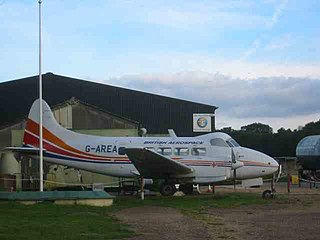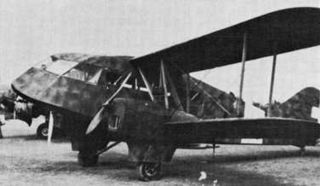Related Research Articles
The Aircraft Manufacturing Company Limited (Airco) was an early British aircraft manufacturer. Established during 1912, it grew rapidly during the First World War, referring to itself as the largest aircraft company in the world by 1918.

The de Havilland Aircraft Company Limited was a British aviation manufacturer established in late 1920 by Geoffrey de Havilland at Stag Lane Aerodrome Edgware on the outskirts of north London. Operations were later moved to Hatfield in Hertfordshire.

The de Havilland DH.82 Tiger Moth is a 1930s British biplane designed by Geoffrey de Havilland and built by the de Havilland Aircraft Company. It was operated by the Royal Air Force (RAF) and other operators as a primary trainer aircraft. In addition to the type's principal use for ab initio training, the Second World War had RAF Tiger Moths operating in other capacities, including maritime surveillance and defensive anti-invasion preparations; some aircraft were even outfitted to function as armed light bombers.

The de Havilland Gipsy Major or Gipsy IIIA is a four-cylinder, air-cooled, inverted inline engine used in a variety of light aircraft produced in the 1930s, including the famous Tiger Moth biplane. Many Gipsy Major engines still power vintage aircraft types.

The de Havilland DH.89 Dragon Rapide is a 1930s short-haul biplane airliner developed and produced by British aircraft company de Havilland. Capable of accommodating 6–8 passengers, it proved an economical and durable craft, despite its relatively primitive plywood construction.

The de Havilland Express, also known as the de Havilland D.H.86, was a four-engined passenger aircraft manufactured by the de Havilland Aircraft Company between 1934 and 1937.

The de Havilland Aircraft Museum, formerly the de Havilland Aircraft Heritage Centre, is a volunteer-run aviation museum in London Colney, Hertfordshire, England. The collection is built around the definitive prototype and restoration shops for the de Havilland Mosquito and also includes several examples of the de Havilland Vampire – the third operational jet aircraft in the world. The museum is the largest such museum devoted to one manufacturer in the country.

The de Havilland DH.84 Dragon is a successful small commercial aircraft that was designed and built by the de Havilland company.

The de Havilland DH.104 Dove is a British short-haul airliner developed and manufactured by de Havilland. The design, which was a monoplane successor to the pre-war Dragon Rapide biplane, came about from the Brabazon Committee report which, amongst other aircraft types, called for a British-designed short-haul feeder for airlines.

The de Havilland DH.60 Moth is a 1920s British two-seat touring and training aircraft that was developed into a series of aircraft by the de Havilland Aircraft Company.

The DH.83 Fox Moth was a successful small biplane passenger aircraft from the 1930s powered by a single de Havilland Gipsy Major I inline inverted engine, manufactured by the de Havilland Aircraft Company.

The de Havilland DH.90 Dragonfly is a 1930s British twin-engined luxury touring biplane built by the de Havilland Aircraft Company at Hatfield Aerodrome.

The Airspeed AS.4 Ferry was three-engined ten-seat biplane airliner designed and built by the British aircraft manufacturer Airspeed Limited. It was the company's first powered aircraft to be produced.

The de Havilland Gipsy Six is a British six-cylinder, air-cooled, inverted inline piston engine developed for aircraft use in the 1930s. It was based on the cylinders of the four-cylinder Gipsy Major and went on to spawn a whole series of similar aero engines that were still in common use until the 1980s.

The Airco DH.11 Oxford was a British twin-engined biplane bomber which was designed to replace the earlier Airco DH.10 Amiens. It was designed to use the unsuccessful ABC Dragonfly engine and was abandoned after the first prototype was built.

The de Havilland DH.34 was a single engined British biplane airliner built by the de Havilland Aircraft Company in the 1920s. 12 were built, with the DH.34 serving with Imperial Airways and its predecessors for several years.

The Breda Ba.44 was a biplane airliner developed in Italy in the mid-1930s and which saw limited military service when impressed into the Regia Aeronautica as transports.

The de Havilland DH.71 Tiger Moth was a British single-seat monoplane, designed to research high-speed flight and to test replacement engines for the Cirrus. Only two were built.

The de Havilland DH.81 Swallow Moth was aimed at the low-cost sporting aircraft market during the Great Depression. It was a single-engined two-seat low-wing monoplane; only one was built.

The de Havilland T.K.2 was a British 1930s single-engined monoplane, designed by students of the de Havilland Aeronautical Technical School. It won two races before World War II, and afterwards set a class closed circuit speed record.
References
Notes
Bibliography
- Jackson, A.J. (1973). British Civil Aircraft since 1919 Volume 2. London: Putnam. p. 382. ISBN 0-370-10010-7.
- Jackson, A.J. (1978). De Havilland Aircraft since 1909. London: Putnam. ISBN 0-370-30022-X.
- Hayes, Paul; King, B. (2003). de Havilland biplane transports. Coulsden: Aviation Classics. ISBN 0-9530413-2-8.